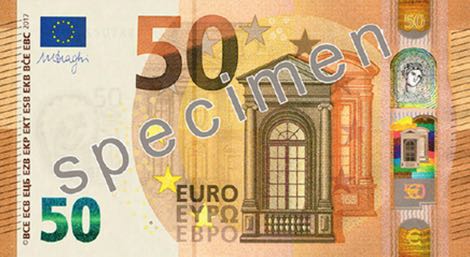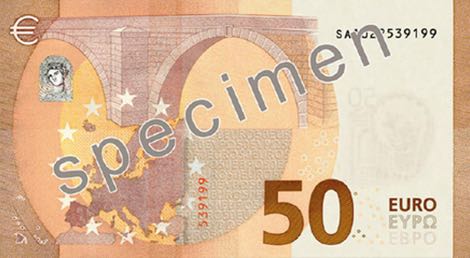On 4 April 2017, the European Central Bank (ECB) will put the new €50 banknote into circulation.
The note incorporates some innovative security features, such as a see-through portrait window in the hologram. The new €50 banknote is the fourth banknote to be launched in the new Europa Series; it was preceded by the new €5 banknote (May 2013), the new €10 banknote (September 2014) and the new €20 banknote (November 2015).


The forger’s favourite banknote – the 50 euros – is getting a new look and high-tech security features.The European Central Bank has unveiled the design that, from April next year, will replace its most widely used and most widely counterfeited bill.At the unveiling in Frankfurt, ECB Executive Board member Yves Mersch explained the notes have a transparent window with a holographic portrait of the Greek mythological figure Europa and a so-called “emerald number” that changes colour from green to blue when viewed at different angles.
The ECB said we are getting to see the note so far ahead of the official release to give the makers of vending, ticketing and other machines that handle cash enough time to make sure it works smoothly with their devices.There was a problem when the new-look five-euro bills were introduced early in 2013. Some machines failed to recognise them, as there had not been time to update the software in all the devices.
Use of the 50-euro note has quadrupled in the past 15 years, with more than 8.5 billion of them in circulation – around 45 percent of the total number.
That reflects a steady rise in cash spending in countries like Germany and Austria where many people are suspicious of electronic payments that can be monitored by authorities. They also prefer physical money that can be stored.
An average German carries around 100 euros at any one time, and 80 percent of German and Austrian purchases are still done with cash, Germany’s Bundesbank estimates.
The comparable figure is less than 40 percent in the United States and about 20 percent in Sweden.The ECB’s Yves Mersch stressed this new note demonstrates its continued commitment to the use of cash, calling it a “trusted and efficient means of payment”.
There were protests against the bank’s decision to scrap the 500-euro note by the end of 2018 because of concerns that it was being used too often for illicit activities including money laundering.The move was seen by many Germans and Austrians as a first step towards eliminating cash, which the ECB firmly denied.The public outcry hinted at broad concern about the fallibility of banks and the need for readily available assets in these uncertain times.




